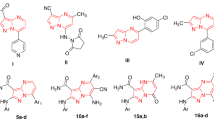Abstract
The synthesis and screening of several fusaric acid (FA) and analogues against five common clinical pathogens (gram-positive and gram-negative) and in vitro hemolytic activity assay in human red blood cells, for the first time, were reported. The biological results reveal that FA and its analogues exhibited moderate antimicrobial activities. Compounds 2–5 and 7 showed growth inhibitory activity in gram-positive bacteria. Compounds 6 and 9 showed growth inhibitory activity in both gram-positive and gram-negative bacteria. None of the compounds induce hemolysis, which is potent for future drug development on this template. In addition, the structure–activity relationship and docking studies are discussed.






Similar content being viewed by others
References
Asano M, Hidaka H (1977) Relaxation ofisolated aorta of the rabbit by picolinic acids. Br J Pharmacol 61:263–269
Ashraf J, Murtaza S, Mughal E, Sadiq A (2017) Synthesis, biological activity and computationalstudies of novel azo-compounds. J Chem Soc Pak 39:65–71
Bacon CW, Porter JK, Norred WP, Leslie JF (1996) Production of fusaricacid by Fusarium species. Appl Environ Microbiol 62:4039–4043
Brown G, Denning D, Gow N, Levitz S, Netea M, White T (2012) Hidden killers: human fungal infections. Sci Transl Med 4:165rv13
D’Alton A, Etherton B (1984) Effects of fusaric acid on tomato root hair membrane potentials and ATP levels. Plant Physiol 74:39–42
Fakhouri W, Walker F, Armbruster W, Buchenauer H (2003) Detoxification offusaric acid by a nonpathogenic Colletotrichum sp. Physiological Mol Plant Pathol 63:263–269
Hitchcock SA, Pennington LD (2006) Structure-brain exposure relationships. J Med Chem 49:7559–7583
Jahnsen RD, Sandberg-Schaal A, Vissing KJ, Nielsen HM, Frimodt-Møller N, Franzyk H (2014) Tailoring cytotoxicity of antimicrobial peptidomimetics with high activity against multidrug-resistant Escherichia Coli. J Med Chem 57:2864–2873
Li C, Zuo C, Deng G, Kuang R, Yang Q, Hu C, Sheng O, Zhang S, Ma L, Wei Y, Yang J, Liu S, Biswas MK, Viljoen A, Yi G (2013) Contamination ofbananas with beauvericin and fusaric acid produced by Fusarium oxysporum f. sp. cubense. PLoS ONE 8:e70226
López-Díaz C, Rahjoo V, Sulyok M, Ghionna V, Martín-Vicente A, Capilla J, Di Pietro A, López-Berges MS (2018) Fusaric acidcontributes to virulence of Fusarium oxysporum on plant and mammalian hosts. Mol Plant Pathol 19:440–453
Mygind PH, Fischer RL, Schnorr KM, Hansen MT, Sonksen CP, Ludvigsen S, Raventos D, Buskov S, Christensen B, De Maria L, Taboureau O, Yaver D, Elvig-Jorgensen SG, Sorensen MV, Christensen BE, Kjaerulff S, Frimodt-Moller N, Lehrer RI, Zasloff M, Kristensen H-H (2005) Plectasin is a peptide antibiotic with therapeutic potential from a saprophytic fungus. Nature 437:975–980
Pajouhesh H, Lenz GR (2005) Medicinal chemical properties of successful central nervous system drugs. NeuroRx 2:541–553
Pan J, Chen Y, Huang Y, Tao Y, Wang J, Li Y, Peng Y, Dong T, Lai X, Lin Y (2011) Antimycobacterialactivity of fusaric acid from a mangrove endophyte and its metal complexes. Arch Pharm Res 34:1177–1181
Qiu X, Janson CA, Smith WW, Green SM, McDevitt P, Johanson K, Carter P, Hibbs M, Lewis C, Chalker A, Fosberry A, Lalonde J, Berge J, Brown P, Houge-Frydrych CS, Jarvest RL (2001) Crystal structure of Staphylococcus aureus tyrosyl-tRNA synthetase in complex with a class of potentand specific inhibitors. Protein Sci 10:2008–2016
Rafique H, Saeed A, Murtaza S, Mughal E, Mumtaz A, Maalik A (2017) Facile synthesis and antibacterial investigation of new ethyl 4-[2-benzamido-4-methylthiazol-3(2H)-yl)] benzoates. Acta Pol Pharm 74:1119–1124
Schmitt MA, Weisblum B, Gellman SH (2007) Interplay among folding, sequence, and lipophilicity in the antibacterial and hemolytic activities of alpha/beta-peptides. J Am Chem Soc 129:417–428
Sharma BK, Singhal PC, Chugh KS (1978) Intravascular haemolysis and acute renal failure following potassium dichromate poisoning. Postgrad Med J 54:414–415
Trott O, Olson AJ (2010) AutoDock Vina: improving the speedand accuracy of docking with a new scoring function, efficient optimization, and multithreading. J Comput Chem 31:455–461
Tung T, Jakobsen T, Dao T, Fuglsang A, Givskov M, Christensen S, Nielsen J (2017) Fusaric acid andanalogues as Gram-negative bacterial quorum sensing inhibitors. Eur J Med Chem 126:1011–1020
Wang M, Xiong Y, Ling N, Feng X, Zhong Z, Shen Q, Guo S (2013) Detection of thedynamic response of cucumber leaves to fusaric acid using thermal imaging. Plant Physiol Biochem 66:68–76
Xiao Z, Ma T, Liao M, Feng Y, Peng X, Li J, Li Z, Wu Y, Luo Q, Deng Y, Liang X, Zhu H (2011) Tyrosyl-tRNA synthetase inhibitors as antibacterial agents: synthesis, molecular docking and structure-activity relationship analysis of 3-aryl-4-arylaminofuran-2(5H)-ones. Eur J Med Chem 46:4904–4914
Yabuta T, Kambe K, Hayashi T (1934) Fusaric acid, a new product of the bakanae fungus. Nippon Nogei Kagaku Kaishi 10:1059–1068
Yin E, Rakhmankulova M, Kucera K, Filho J, Portero CE, Narvaez-Trujillo A, Holley SA, Strobel SA (2015) Fusaric acid inducesa notochord malformation in zebrafish via copper chelation. Biometals 28:783–789
Acknowledgements
This research is funded by The PHENIKAA University Foundation for Science and Technology Development. The authors would like to thank Prof. Niels Frimodt-Møller, Department of Clinical Microbiology, Rigshospitalet, Københavns Universitet, Denmark for hemolytic activity assay. We would like to thank Prof. John Nielsen, Department of Drug Design and Pharmacology, Københavns Universitet, Denmark for essential support at an early stage of the fusaric acid project.
Author information
Authors and Affiliations
Corresponding author
Ethics declarations
Conflict of interest
The authors declare that they have no conflict of interest.
Additional information
Publisher’s note Springer Nature remains neutral with regard to jurisdictional claims in published maps and institutional affiliations.
Rights and permissions
About this article
Cite this article
Thanh, T.T., Quoc, T.N. & Xuan, H.L. Fusaric acid and derivatives as novel antimicrobial agents. Med Chem Res 29, 1689–1696 (2020). https://doi.org/10.1007/s00044-020-02596-3
Received:
Accepted:
Published:
Issue Date:
DOI: https://doi.org/10.1007/s00044-020-02596-3




